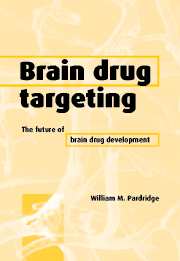Book contents
- Frontmatter
- Contents
- Preface
- List of abbreviations
- 1 Drug targeting, drug discovery, and brain drug development
- 2 Invasive brain drug delivery
- 3 Lipid-mediated transport and carrier-mediated transport of small molecules
- 4 Receptor-mediated transcytosis of peptides
- 5 Vector discovery: genetically engineered Trojan horses for drug targeting
- 6 Linker strategies: the engineering of multifunctional drug formulations
- 7 Protein neurotherapeutics and peptide radiopharmaceuticals
- 8 Antisense neurotherapeutics and imaging gene expression in vivo
- 9 Gene therapy of the brain
- 10 Blood–brain barrier genomics
- References
- Index
- Plate section
2 - Invasive brain drug delivery
Published online by Cambridge University Press: 08 January 2010
- Frontmatter
- Contents
- Preface
- List of abbreviations
- 1 Drug targeting, drug discovery, and brain drug development
- 2 Invasive brain drug delivery
- 3 Lipid-mediated transport and carrier-mediated transport of small molecules
- 4 Receptor-mediated transcytosis of peptides
- 5 Vector discovery: genetically engineered Trojan horses for drug targeting
- 6 Linker strategies: the engineering of multifunctional drug formulations
- 7 Protein neurotherapeutics and peptide radiopharmaceuticals
- 8 Antisense neurotherapeutics and imaging gene expression in vivo
- 9 Gene therapy of the brain
- 10 Blood–brain barrier genomics
- References
- Index
- Plate section
Summary
Introduction
Invasive brain drug delivery strategies have been the most widely used for circum-venting the blood–brain barrier (BBB) drug delivery problem. The invasive strategies require either a craniotomy by a neurosurgeon or access to the carotid artery by an interventional radiologist. The neurosurgery-based strategies include intracerebroventricular (ICV) infusion of drugs, or intracerebral implants of either genetically engineered cells or biodegradable polymers. Thus, the neurosurgicalbased strategies fundamentally emanate from the material sciences and employ controlled-release formulations, which is a classical drug delivery strategy (Figure 2.1). In contrast, the theme of this book is that brain drug targeting emanates from transport biology science, and is focused on the endogenous BBB transport systems (Figure 2.1). In the absence of brain drug-targeting strategies that allow drugs to be transported through the BBB, thenit is necessary to employ invasive strategies. These approaches either deliver drug behind the BBB, as with either ICV infusion or intracerebral implants, or physically disrupt the BBB following the intracarotid arterial infusion of noxious agents.
Neurosurgical implants
Intracerebroventricular infusion
Cerebrospinal fluid (CSF) physiology
The failure of a blood-borne agent to cross the brain cpillary endothelial wall, which forms the BBB in vivo, is illustrated with the light microscopic histochemical study (Brightman, 1977), as shown in Figure 2.2. In this study, horseradish peroxidase HRP) was injected either intravenously or by ICV injection.
- Type
- Chapter
- Information
- Brain Drug TargetingThe Future of Brain Drug Development, pp. 13 - 35Publisher: Cambridge University PressPrint publication year: 2001
- 7
- Cited by



